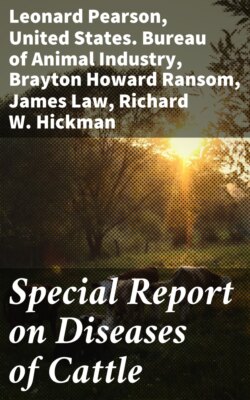Читать книгу Special Report on Diseases of Cattle - Lowe - Страница 156
На сайте Литреса книга снята с продажи.
LIGHTNING STROKE (ASPHYXIA ELECTRICA).
ОглавлениеWhen an animal is struck by lightning the shock is instantaneously expended on the nervous system, and as a rule death occurs immediately; but when the shock is not fatal animation is suspended to a greater or less extent, as evidenced by prostration, unconsciousness, and paralysis.
Symptoms.—When not fatal, the symptoms vary much, according to the severity of the shock. The animal usually falls, as from an apoplectic attack, and, as a matter of course, the symptoms are such as are generally manifested in connection with concussion of the brain. The muscular system may be completely relaxed; the legs limber; the muscles flabby and soft to the touch; or there may be convulsions, spasms, and twitching of the muscles. The breathing is generally labored, irregular, or interrupted, and slower than normal. In most instances the electrical fluid leaves its mark by singeing the hair, or by inflicting wounds, burns, or blisters.
Treatment.—So long as the beating of the heart is perceptible the endeavor to resuscitate the animal should be continued. Dash cold water over the head and body; rub the body and legs; smartly whip the body with wet towels or switches. Mustard, mixed with water, should be well rubbed over the legs and back of the head on each side of the neck. Inject into the rectum 4 drams of stronger liquor ammonia, or 1½ ounces of hartshorn diluted with a quart of warm water. Cautiously hold an uncorked bottle of hartshorn to the nostrils, so that some of it is inhaled, but care should be taken that too much is not suddenly inhaled. If the animal is unconscious, hypodermic injections of stimulants are indicated, such as 6 drams of camphorated oil in one dose, subcutaneously, or 20 grains of caffein or ½ grain of strychnin, also subcutaneously.
When the animal revives sufficiently to be able to swallow, 4 drams of the stronger liquor ammonia, diluted with a quart of cold water, should be given as a drench, and the dose should be repeated in an hour. One and one-half ounces of ordinary hartshorn may be used instead of the stronger liquor ammonia, but, like the latter, it should be diluted with a quart or more of water, and even then care should be exercised in drenching.
In cases where the shock has not caused complete insensibility recovery may be hastened by the ammonia and water drench, or 4 ounces of brandy diluted with a quart of water, or 8 ounces of whisky diluted with a quart of water. These doses may be given every three or four hours if necessary. After recovery from the more serious symptoms 2 drams of sulphate of quinin should be given twice a day until health is restored. If any paralysis remains 1½ drams of pulverized nux vomica should be given twice a day with the quinin.
The foregoing treatment is also applicable when the electrical shock is given by telephone, electric car, or electric-light wires, etc. The wounds, burns, or blisters should be treated according to the antiseptic method of treating wounds.
